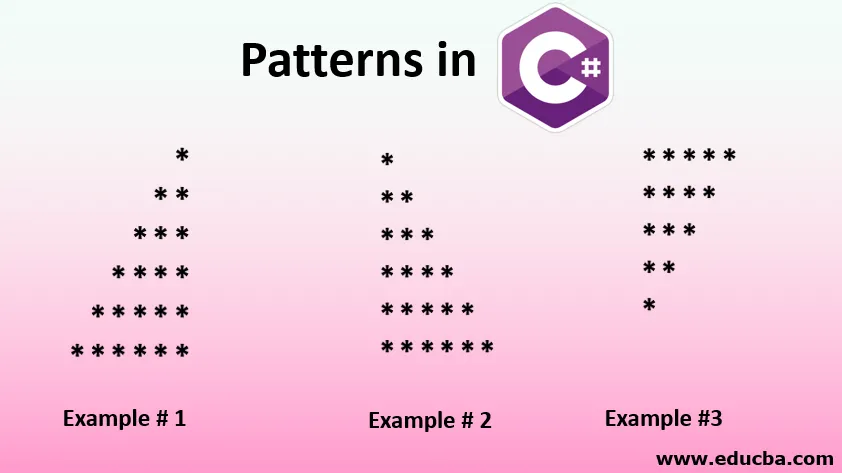
Einführung in Patterns in C #
Muster sind die wiederholte dekorative Gestaltung. Es gibt einen einfachen Code zum Schreiben von Mustern in C #. Wir können Code schreiben, um verschiedene Arten von Mustern wie Sternchenmuster, Zeichenmuster und Zahlenmuster zu drucken. Nachfolgend finden Sie verschiedene Beispiele zum Drucken von Stern-, Zeichen- und Zahlenmustern. Diese Beispiele bestehen aus Schleifen oder verschachtelten Schleifen, bei denen es sich um eine Schleife innerhalb einer Schleife handelt. Muster sind eine Möglichkeit, nacheinander oder auf logische Weise zu entwerfen. Wir können Dreiecke, Pyramiden, Diamanten und andere Symmetrien drucken.
Top 3 Arten von Mustern in C #
Die drei wichtigsten Mustertypen in c # sind nachstehend aufgeführt.
1. Sternchen
Das Folgende sind Beispiele zum Drucken von Sternchenmustern.
Beispiel 1
using System;
using System.Collections.Generic;
using System.Linq;
using System.Text;
namespace StarPattern
(
class Program
(
static void Main(string() args)
(
int x, y, z;
for (x =6; x >= 1; x--)
(
for (y = 1; y < x; y++)
(
Console.Write(" ");
)
for (z = 6; z >= x; z--)
(
Console.Write("*");
)
Console.WriteLine();
)
Console.ReadLine();
)
)
)
Ausgabe:

Beispiel # 2
using System;
using System.Collections.Generic;
using System.Linq;
using System.Text;
namespace StarPattern
(
class Program
(
static void Main(string() args)
(
int x, y;
for (x = 1; x <= 6; x++)
(
for (y = 1; y <= x; y++)
(
Console.Write("*");
)
Console.WriteLine();
)
Console.ReadLine();
)
)
)
Ausgabe:

Beispiel # 3
using System;
using System.Collections.Generic;
using System.Linq;
using System.Text;
namespace StarPattern
(
class Program
(
static void Main(string() args)
(
int x, y;
for (x = 5; x >= 1; x--)
(
for (y = 1; y <= x; y++)
(
Console.Write("*");
)
Console.WriteLine();
)
Console.ReadLine();
)
)
)
Ausgabe:

Beispiel # 4
using System;
using System.Collections.Generic;
using System.Linq;
using System.Text;
namespace StarPattern
(
class Program
(
static void Main(string() args)
(
int x, y, z;
for (x = 5; x >= 1; x--)
(
for (y = 5; y > x; y--)
(
Console.Write(" ");
)
for (z = 1; z <=x; z++)
(
Console.Write("*");
)
Console.WriteLine();
)
Console.ReadLine();
)
)
)
Ausgabe:

Beispiel # 5
using System;
using System.Collections.Generic;
using System.Linq;
using System.Text;
namespace StarPattern
(
class Program
(
static void Main(string() args)
(
int x, y, z;
for (x= 1; x <= 5; x++)
(
for (y = x; y < 5; y++)
(
Console.Write(" ");
)
for (z = 1; z < (x * 2); z++)
(
Console.Write("*");
)
Console.WriteLine();
)
Console.ReadLine();
)
)
)
Ausgabe:

Beispiel # 6
using System;
using System.Collections.Generic;
using System.Linq;
using System.Text;
namespace StarPattern
(
class Program
(
static void Main(string() args)
(
int x, y, z;
for (x = 5; x >= 1; x--)
(
for (y = 5; y > x; y--)
(
Console.Write(" ");
)
for (z = 1; z < (x * 2); z++)
(
Console.Write("*");
)
Console.WriteLine();
)
Console.ReadLine();
)
)
)
Ausgabe:

Beispiel # 7
using System;
using System.Collections.Generic;
using System.Linq;
using System.Text;
namespace StarPattern
(
class Program
(
static void Main(string() args)
(
int x, y;
for (x = 1; x <= 5; x++)
(
for (y = x; y < 5; y++)
(
Console.Write(" ");
)
for (y = 1; y <= (2 * x - 1); y++)
(
if (x == 5 || y == 1 || y == (2 * x - 1))
(
Console.Write("*");
)
else
(
Console.Write(" ");
)
)
Console.WriteLine();
)
Console.ReadLine();
)
)
)
Ausgabe:

Beispiel # 8
using System;
using System.Collections.Generic;
using System.Linq;
using System.Text;
namespace CharacterPattern
(
class Program
(
static void Main(string() args)
(
int x, y;
for (x = 1; x <= 5; x++)
(
for (y = 1; y <= 5; y++)
(
Console.Write("*");
)
Console.WriteLine();
)
Console.ReadLine();
)
)
)
Ausgabe:

Beispiel # 9
using System;
using System.Collections.Generic;
using System.Linq;
using System.Text;
namespace CharacterPattern
(
class Program
(
static void Main(string() args)
(
int x, y;
for (x = 1; x <= 5; x++)
(
for (y = 1; y <= x; y++)
(
if (y == 1 || y== x || x == 5)
(
Console.Write("*");
)
else
(
Console.Write(" ");
)
)
Console.WriteLine();
)
Console.ReadLine();
)
)
)
Ausgabe:

2. Zahlenmuster
Im Folgenden finden Sie Beispiele zum Drucken von Zahlenmustern.
Beispiel 1
using System;
using System.Collections.Generic;
using System.Linq;
using System.Text;
namespace NumberPattern
(
class Program
(
static void Main(string() args)
(
int x, y;
for (x = 1; x <= 5; x++)
(
for (y = 1; y <= x; y++)
(
Console.Write(y);
)
Console.WriteLine();
)
Console.ReadLine();
)
)
)
Ausgabe:

Beispiel # 2
using System;
using System.Collections.Generic;
using System.Linq;
using System.Text;
namespace NumberPattern
(
class Program
(
static void Main(string() args)
(
int x, y;
for (x = 5; x >= 1; x--)
(
for (y = 1; y <= x; y++)
(
Console.Write(y);
)
Console.WriteLine();
)
Console.ReadLine();
)
)
)
Ausgabe:
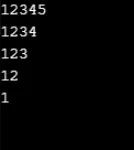
Beispiel # 3
using System;
using System.Collections.Generic;
using System.Linq;
using System.Text;
namespace NumberPattern
(
class Program
(
static void Main(string() args)
(
int x, y;
for (x = 5; x >= 1; x--)
(
for (y = x; y <= 5; y++)
(
Console.Write(y);
)
Console.WriteLine();
)
Console.ReadLine();
)
)
)
Ausgabe:
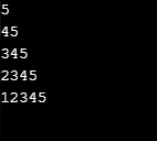
Beispiel # 4
using System;
using System.Collections.Generic;
using System.Linq;
using System.Text;
namespace NumberPattern
(
class Program
(
static void Main(string() args)
(
int x, y;
for (x = 1; x <= 5; x++)
(
for (y = x; y <= 5; y++)
(
Console.Write(y);
)
Console.WriteLine();
)
Console.ReadLine();
)
)
)
Ausgabe:

Beispiel # 5
using System;
using System.Collections.Generic;
using System.Linq;
using System.Text;
using System.Threading.Tasks;
namespace NumberPattern
(
class Program
(
static void Main(string() args)
(
int x, y;
for (x = 1; x <= 5; x++)
(
for (y = 1; y <= x; y++)
(
Console.Write(x);
)
Console.WriteLine();
)
Console.ReadLine();
)
)
)
Ausgabe:

Beispiel # 6
using System;
using System.Collections.Generic;
using System.Linq;
using System.Text;
using System.Threading.Tasks;
namespace NumberPattern
(
class Program
(
static void Main(string() args)
(
int x, y;
for (x = 5; x >= 1; x--)
(
for (y = 5; y >= x; y--)
(
Console.Write(x);
)
Console.WriteLine();
)
Console.ReadLine();
)
)
)
Ausgabe:

Beispiel # 7
using System;
using System.Collections.Generic;
using System.Linq;
using System.Text;
using System.Threading.Tasks;
namespace NumberPattern
(
class Program
(
static void Main(string() args)
(
int x, y;
for (x = 5; x >= 1; x--)
(
for (y = 1; y <= x; y++)
(
Console.Write(x);
)
Console.WriteLine();
)
Console.ReadLine();
)
)
)
Ausgabe:

Beispiel # 8
using System;
using System.Collections.Generic;
using System.Linq;
using System.Text;
using System.Threading.Tasks;
namespace NumberPattern
(
class Program
(
static void Main(string() args)
(
int x, y;
for (x = 1; x <= 5; x++)
(
for (y = 5; y >= x; y--)
(
Console.Write(x);
)
Console.WriteLine();
)
Console.ReadLine();
)
)
)
Ausgabe:

Beispiel # 9
using System;
using System.Collections.Generic;
using System.Linq;
using System.Text;
using System.Threading.Tasks;
namespace NumberPattern
(
class Program
(
static void Main(string() args)
(
int x, y;
for (x = 6; x >= 1; x--)
(
for (y = x; y >= 1; y--)
(
Console.Write(y);
)
Console.WriteLine();
)
Console.ReadLine();
)
)
)
Ausgabe:

Beispiel # 10
using System;
using System.Collections.Generic;
using System.Linq;
using System.Text;
using System.Threading.Tasks;
namespace NumberPattern
(
class Program
(
static void Main(string() args)
(
int x, y;
for (x = 1; x <= 5; x++)
(
for (y = 6; y >= x; y--)
(
Console.Write(y);
)
Console.WriteLine();
)
Console.ReadLine();
)
)
)
Ausgabe:

Beispiel # 11
using System;
using System.Collections.Generic;
using System.Linq;
using System.Text;
using System.Threading.Tasks;
namespace NumberPattern
(
class Program
(
static void Main(string() args)
(
int x, y;
for (x = 7; x >= 1; x -= 2)
(
for (y = 1; y <= x; y++)
(
Console.Write(y);
)
Console.WriteLine();
)
Console.ReadLine();
)
)
)
Ausgabe:
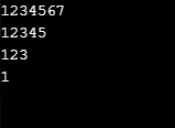
3. Zeichenmuster
Das Es folgen Beispiele zum Drucken von Zeichenmustern.
Beispiel 1
using System;
using System.Collections.Generic;
using System.Linq;
using System.Text;
namespace CharacterPattern
(
class Program
(
static void Main(string() args)
(
int x, y;
int z = 5;
for (x = 1; x <= z; x++)
(
for (y = 1; y <= x; y++)
(
Console.Write((char)(x + 64));
)
Console.WriteLine("");
)
Console.ReadLine();
)
)
)
Ausgabe:

Beispiel # 2
using System;
using System.Collections.Generic;
using System.Linq;
using System.Text;
namespace CharacterPattern
(
class Program
(
static void Main(string() args)
(
int x, y;
int z = 5;
for (x = 1; x <= z; x++)
(
for (y = x; y <= z; y++)
(
Console.Write((char)(x + 64));
)
Console.WriteLine("");
)
Console.ReadLine();
)
)
)
Ausgabe:

Beispiel # 3
using System;
using System.Collections.Generic;
using System.Linq;
using System.Text;
namespace CharacterPattern
(
class Program
(
static void Main(string() args)
(
int x, y;
int z = 5;
for (x = 1; x <= z; x++)
(
for (y = 1; y <= x; y++)
(
Console.Write((char)(z - x + 1 + 64));
)
Console.WriteLine("");
)
Console.ReadLine();
)
)
)
Ausgabe:

Beispiel # 4
using System;
using System.Collections.Generic;
using System.Linq;
using System.Text;
namespace CharacterPattern
(
class Program
(
static void Main(string() args)
(
int x, y;
int z = 5;
for (x = 1; x <= z; x++)
(
for (y = x; y<= z; y++)
(
Console.Write((char)(y + 64));
)
Console.WriteLine();
)
Console.ReadLine();
)
)
)
Ausgabe:
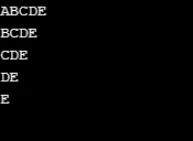
Beispiel # 5
using System;
using System.Collections.Generic;
using System.Linq;
using System.Text;
namespace CharacterPattern
(
class Program
(
static void Main(string() args)
(
int x, y, z;
int k = 5;
for (x = 1; x <= k; x++)
(
for (y = 1; y <= k - x; y++)
(
Console.Write(" ");
)
for (z = 1; z <= x; z++)
(
Console.Write((char)(x + 64));
)
Console.WriteLine();
)
Console.ReadLine();
)
)
)
Ausgabe:

Beispiel # 6
using System;
using System.Collections.Generic;
using System.Linq;
using System.Text;
namespace CharacterPattern
(
class Program
(
static void Main(string() args)
(
int x, y;
int a = 5;
for (x = 1; x <= a; x++)
(
for (y = x; y >= 1; y--)
(
Console.Write((char)(y + 64));
)
Console.WriteLine("");
)
Console.ReadLine();
)
)
)
Ausgabe:

Beispiel # 7
using System;
using System.Collections.Generic;
using System.Linq;
using System.Text;
namespace CharacterPattern
(
class Program
(
static void Main(string() args)
(
int x, y;
int a = 5;
for (x = a; x >= 1; x--)
(
for (y = a; y >= x; y--)
(
Console.Write((char)(y + 64));
)
Console.WriteLine("");
)
Console.ReadLine();
)
)
)
Ausgabe:

Beispiel # 8
using System;
using System.Collections.Generic;
using System.Linq;
using System.Text;
namespace CharacterPattern
(
class Program
(
static void Main(string() args)
(
int x, y;
int a = 5;
for (x = 1; x <= a; x++)
(
for (y = a; y >= x; y--)
(
Console.Write((char)(y + 64));
)
Console.WriteLine("");
)
Console.ReadLine();
)
)
)
Ausgabe:

Beispiel # 9
using System;
using System.Collections.Generic;
using System.Linq;
using System.Text;
namespace CharacterPattern
(
class Program
(
static void Main(string() args)
(
int x, y;
int z = 5;
for (x = z; x >= 1; x--)
(
for (y = x; y >= 1; y--)
(
Console.Write((char)(y + 64));
)
Console.WriteLine("");
)
Console.ReadLine();
)
)
)
Ausgabe:
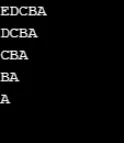
Beispiel # 10
using System;
using System.Collections.Generic;
using System.Linq;
using System.Text;
namespace CharacterPattern
(
class Program
(
static void Main(string() args)
(
int x, y;
int z = 6;
for (x = 1; x <= z; x++)
(
for (y = 1; y<= z - x; y++)
(
Console.Write(" ");
)
for (y = 1; y <= x; y++)
(
Console.Write((char)(y + 64));
)
for (y = x - 1; y >= 1; y--)
(
Console.Write((char)(y + 64));
)
Console.WriteLine();
)
Console.ReadLine();
)
)
)
Ausgabe:

Fazit
So oben sind einige Beispiele für verschiedene Arten von Mustern. Wir können jede Art von Muster mit einigen Änderungen in den Schleifen drucken.
Empfohlene Artikel
Dies ist eine Anleitung zu Mustern in C #. Hier diskutieren wir die Einführung und die Top-3-Arten von Mustern in C # zusammen mit ihren Beispielen und der Code-Implementierung. Sie können sich auch die folgenden Artikel ansehen, um mehr zu erfahren.
- Was ist ein Entwurfsmuster in C #?
- Fragen im Vorstellungsgespräch zu C # Design Pattern
- 2D-Arrays in C #
- Überschreiben in C #
- In Java überschreiben
- 3 verschiedene Arten von Arrays in PHP (Beispiele)
- Zahlenmuster in Java mit Beispielen